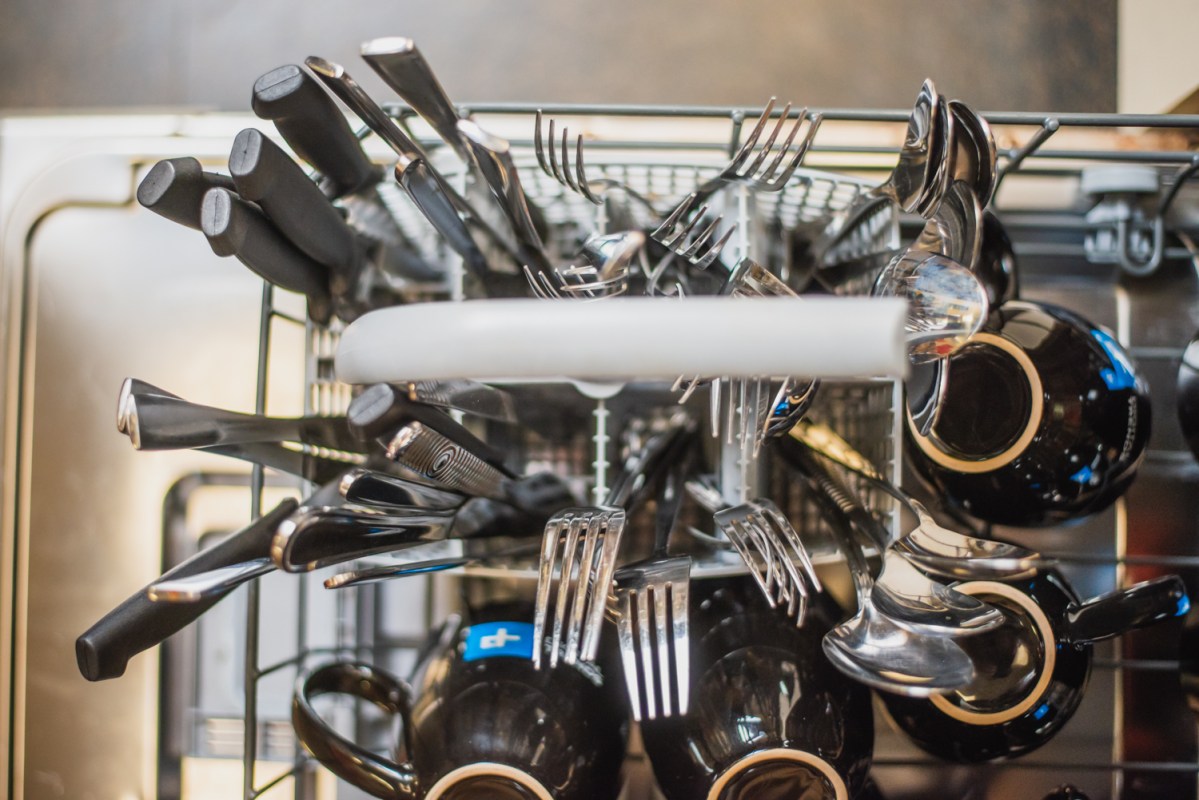
The other day I overheard a coworker in our office chastise another coworker for putting a knife sharp side up in the office dishwasher silverware caddy. “It’s a safety hazard!” First colleague informed second colleague, who lowered her head in shame.
The comment ignited a heated debate in the office kitchen: silverware handles up or down?
“Definitely down,” noted one coworker. “It gets them cleaner.”
“You’re crazy,” responded the other. “Definitely handles up! That way, when you grab the fork, you aren’t touching the part that people put in their mouths!”
I have to admit that I agree with coworker two. Growing up, I was taught that handles should be up so that the forks and spoons are closer to the jets on the bottom of the dishwasher and so you don’t stab yourself in the hand when retrieving your fork. Plus, when you pull the silverware out, you aren’t putting your grubby paws on the part of the silverware that someone is eventually going to stuff into their mouth.
My husband has always been firmly on Team #HandlesUp as well, so I’ve lived pretty much my whole life thinking I was loading the dishwasher properly. Throughout my working career, I’d silently shake my head at fork prongs sticking up in office dishwashers. “Amateurs,” I would think to myself.
There are 2 types of people:
1. Those who load silverware into the dishwasher w/handles up.
2. Maniacs who don't.
— Beau Coffron (@lunchboxdad) June 23, 2016
But my colleagues’ conversation got me thinking. Maybe I’m the amateur at loading the dishwasher. And as Home Editor at Digital Trends who’s in charge of appliance reviews, I figured it was a question I should know the answer to.
So, I decided to do a little research, as well as ask some people who actually know a thing or two about dishwashers — appliance manufacturers — to get the answer to this age-old question once and for all. Is it handles up, or handles down?
It turns out, the answer to the question depends on who you ask — and who’s using the dishwasher.
Knife tips down
I reached out to Samsung, LG, Whirlpool, GE Appliances, and Kenmore to get some answers. In my quest for knowledge, I was fully expecting to validate my way of doing things.
“Unless you live life on the edge, place handles going up to avoid the sharp edges.”
Unfortunately, that’s not what happened. Turns out, there’s not really across-the-board agreement on proper etiquette — except everyone agrees that loading or unloading the dishwasher should not lead to accidental stabbings. In other words, the sharp end of a knife should be down with the handle up.
“Unless you live life on the edge, place handles going up to avoid the sharp edges,” Taryn Brucia, director of public relations for LG Electronics, told Digital Trends.
Mike Nerdig, senior commercial director of dishwashers at GE Appliances, says handles up for knives and forks to prevent accidental stabbings, but handles down for spoons. He also offered a few other nuggets of proper loading etiquette I hadn’t thought about:
“For best washing, place your flatware in the removable silverware baskets,” Nerdig told Digital Trends. “Avoid letting your spoons, and all other silverware, well, spoon. Letting items clump and nest together will keep them from being properly washed.”

A Samsung spokesperson told me that while you should always look at your dishwasher manual first, for the most part, all silverware should be placed in the dishwasher handles down, sharp edges or not.
Both Kenmore and Whirlpool agreed with the knife handles up, rest of handles down for best cleaning. Whirlpool Corporation’s Institute of Home Science also recommended checking on whether any knives other than butter knives should even go in the dishwasher before throwing them in there.
Have I been doing it wrong? Not so fast.
So … with the exception of GE Appliances, most dishwasher manufacturers essentially told me that I’ve been loading the dishwasher wrong all these years.
But it turns out that not everyone agrees with the handles down rule all the time.
For maximum cleaning efficiency, it should be a combination of both handles up and down so that eating utensils don’t nest together.
Electrolux says that for maximum cleaning efficiency, it should be a combination of both handles up and down so that eating utensils don’t nest together.
And according to Leslie Reichert, a “cleaning coach” with a big following on Facebook, you should go ahead and put those handles up, especially when kids are involved.
“I recommend this if you are having your children learn to empty the dishwasher, or you really want to avoid transferring germs from your hands to the eating surfaces of the silverware,” she told Reader’s Digest.
So what’s the verdict?
While I started this journey hoping for a clear answer (and let’s be honest — to validate my way of doing things), what I’ve found instead is less clarity on than ever. Handles up, handles down, what does it all mean for humanity?
I have a four-year-old who is learning household chores. I’m positive that, while I ask him to wash his hands frequently, his cute little paws are grubby with germs. I don’t want him putting a thumbprint on the spoon I’m going to use for dinner. So that means I’m going to continue doing things the way I do them: handles up.
I’d also say that if you’re a handles down person, well, good for you. Keep on rockin’ in the free world. Just don’t get mad at me at the office when I put that spoon in the dishwasher with the handle up. You know, out of habit. Because depending on who you ask, we’re both doing it correctly. And honestly, I’m just glad we’re all loading the dishwasher rather than throwing stuff in the sink.


